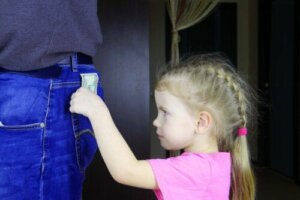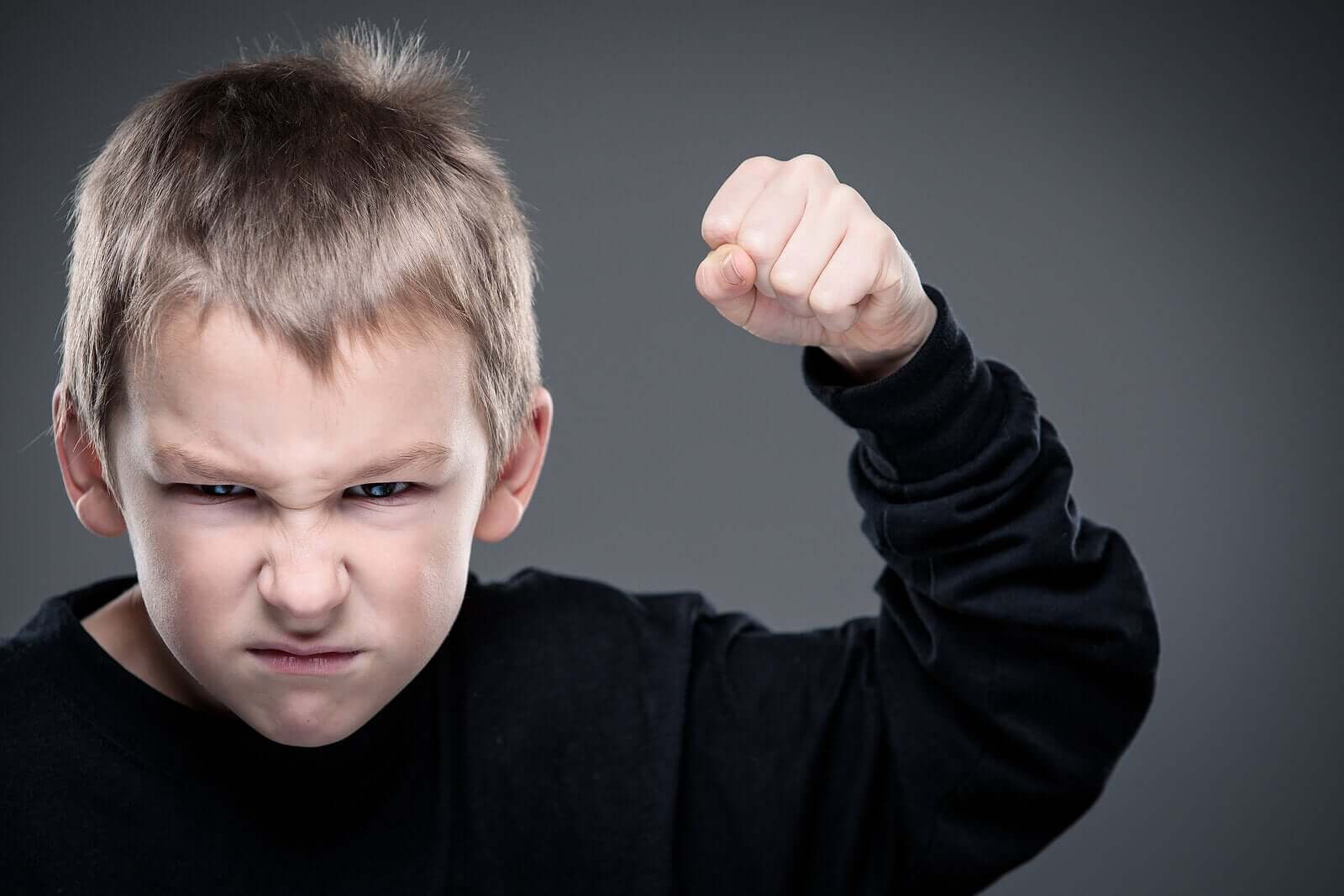Antisocial Conduct Disorder: Symptoms, Causes and Treatment

Antisocial conduct disorder is a disorder that usually appears at an early age, around 5 or 6 years old. It’s characterized by a deficiency in emotional and behavioral control that leads the child to not respect the rights of others or to conform to social norms. Early detection is important in order to find a solution as soon as possible.
We all live in society and, therefore, we must respect the rights of others by following certain rules. In general, people respect these rules, as it’s something we’ve already internalized. However, those who suffer from this condition are unable to respect them.
What is antisocial conduct disorder?
Antisocial conduct disorder is common in young children, although it can occur at other times in child development. It involves behaviors that violate the rights of others, don’t respect social norms, and cause confrontations with authority figures.

In order to diagnose a child with antisocial conduct disorder, these behaviors must occur in a persistent and repetitive way for at least 12 months. Those who suffer from it usually have aggressive behaviors against people or animals (sometimes they can even torture small animals). They may also steal, lie, etc.
These children experience significant deterioration in several areas, such as school and social life. They feel little empathy and ignore the feelings of others. What’s more, most of the time, they act impulsively without thinking about the consequences.
Symptoms of antisocial conduct disorder
To make a diagnosis, 15 symptoms must have been present in the last year and at least 1 in the last 6 months. Thus, the symptoms are organized as follows:
- Property destruction: Can cause fires or destroy property.
- Fraud or theft: Non-confrontational theft, lying, cheating, attacking other people’s homes or cars.
- Assault on animals and people: Threatens, intimidates, starts physical fights, is cruel to people or animals, brags, etc.
- Serious violation of rules: Runs away from home, misses school without authorization, doesn’t come home at night, etc.
There are 3 types of antisocial conduct disorder, depending on the age at which symptoms begin:
- Childhood. The symptoms appear before the age of 10 and can last throughout adult life and be associated with an antisocial personality disorder. It tends to have a more serious prognosis.
- Adolescence. Begins after age 10; less severe and deteriorating. It is associated with higher levels of rebelliousness and rejection of social norms.
- Not specified. This diagnosis refers to cases where it’s difficult to establish the age of onset of symptoms.
Causes of antisocial conduct disorder
There are several causes that may influence the onset of antisocial conduct disorder. What’s more, at times, they may interact with each other.
- Cognitive.
- Genetic: Existence of a family history of the condition.
- Personal: History of attention deficit and hyperactivity disorder (ADHD) or oppositional defiant disorder.
- Socioeconomic: Living in marginal and low socioeconomic environments.
- Family: Dysfunctional families, substance abuse, mistreatment, abuse, child neglect, and inappropriate educational styles.
- Psychophysiological: Poor reaction of the autonomic nervous system.
- Temperamental: Difficult character, emotional insensitivity, low avoidance of harm.
- Relationship with neurotransmitters: Malfunctioning of noradrenaline and serotonin.
- Relationship with peers with behavioral problems.
Treatment of antisocial conduct disorder
Today, there’s still no fully established treatment. Often, treatment involves programs in which parents and children play a crucial role along with professionals from different disciplines.
Psychotherapy
- Training programs in social and communication skills, problem solving.
- Reinforcement of prosocial behaviors, modeling, behavioral contracts, and emotional expression
- Use of cognitive-behavioral programs: Teaching positive ways to relate and providing alternative behaviors to those of the disorder.
- Psychoeducation of parents: Teaching parents how to act in the face of antisocial conduct disorder.

In very complicated cases, medication with drugs such as selective serotonin reuptake inhibitors (SSRIs) may be recommended.
Recommendations for parents
- Educate in an assertive and democratic style.
- Avoid overprotection, indifference and overdemanding.
- When establishing the rules, explain the consequences of non-compliance and be consistent at all times.
- Develop the repertoire of social and communication skills.
- Provide emotional and social support to encourage optimal development.
- Be insistent on emotional regulation and education.
- Teach problem-solving strategies as an alternative to aggression.
- Seek professional help to support this process.
Regarding antisocial conduct disorder…
In short, dissociative behavior disorder must be detected as soon as the first symptoms appear in order to start treatment and thus improve its prognosis.
If there’s even the slightest concern that your child may suffer from this disorder, it’s important that you seek professional help to make a thorough evaluation and begin treatment as soon as possible. Don’t despair, be patient, and stay calm. Things will gradually get better.
Antisocial conduct disorder is a disorder that usually appears at an early age, around 5 or 6 years old. It’s characterized by a deficiency in emotional and behavioral control that leads the child to not respect the rights of others or to conform to social norms. Early detection is important in order to find a solution as soon as possible.
We all live in society and, therefore, we must respect the rights of others by following certain rules. In general, people respect these rules, as it’s something we’ve already internalized. However, those who suffer from this condition are unable to respect them.
What is antisocial conduct disorder?
Antisocial conduct disorder is common in young children, although it can occur at other times in child development. It involves behaviors that violate the rights of others, don’t respect social norms, and cause confrontations with authority figures.

In order to diagnose a child with antisocial conduct disorder, these behaviors must occur in a persistent and repetitive way for at least 12 months. Those who suffer from it usually have aggressive behaviors against people or animals (sometimes they can even torture small animals). They may also steal, lie, etc.
These children experience significant deterioration in several areas, such as school and social life. They feel little empathy and ignore the feelings of others. What’s more, most of the time, they act impulsively without thinking about the consequences.
Symptoms of antisocial conduct disorder
To make a diagnosis, 15 symptoms must have been present in the last year and at least 1 in the last 6 months. Thus, the symptoms are organized as follows:
- Property destruction: Can cause fires or destroy property.
- Fraud or theft: Non-confrontational theft, lying, cheating, attacking other people’s homes or cars.
- Assault on animals and people: Threatens, intimidates, starts physical fights, is cruel to people or animals, brags, etc.
- Serious violation of rules: Runs away from home, misses school without authorization, doesn’t come home at night, etc.
There are 3 types of antisocial conduct disorder, depending on the age at which symptoms begin:
- Childhood. The symptoms appear before the age of 10 and can last throughout adult life and be associated with an antisocial personality disorder. It tends to have a more serious prognosis.
- Adolescence. Begins after age 10; less severe and deteriorating. It is associated with higher levels of rebelliousness and rejection of social norms.
- Not specified. This diagnosis refers to cases where it’s difficult to establish the age of onset of symptoms.
Causes of antisocial conduct disorder
There are several causes that may influence the onset of antisocial conduct disorder. What’s more, at times, they may interact with each other.
- Cognitive.
- Genetic: Existence of a family history of the condition.
- Personal: History of attention deficit and hyperactivity disorder (ADHD) or oppositional defiant disorder.
- Socioeconomic: Living in marginal and low socioeconomic environments.
- Family: Dysfunctional families, substance abuse, mistreatment, abuse, child neglect, and inappropriate educational styles.
- Psychophysiological: Poor reaction of the autonomic nervous system.
- Temperamental: Difficult character, emotional insensitivity, low avoidance of harm.
- Relationship with neurotransmitters: Malfunctioning of noradrenaline and serotonin.
- Relationship with peers with behavioral problems.
Treatment of antisocial conduct disorder
Today, there’s still no fully established treatment. Often, treatment involves programs in which parents and children play a crucial role along with professionals from different disciplines.
Psychotherapy
- Training programs in social and communication skills, problem solving.
- Reinforcement of prosocial behaviors, modeling, behavioral contracts, and emotional expression
- Use of cognitive-behavioral programs: Teaching positive ways to relate and providing alternative behaviors to those of the disorder.
- Psychoeducation of parents: Teaching parents how to act in the face of antisocial conduct disorder.

In very complicated cases, medication with drugs such as selective serotonin reuptake inhibitors (SSRIs) may be recommended.
Recommendations for parents
- Educate in an assertive and democratic style.
- Avoid overprotection, indifference and overdemanding.
- When establishing the rules, explain the consequences of non-compliance and be consistent at all times.
- Develop the repertoire of social and communication skills.
- Provide emotional and social support to encourage optimal development.
- Be insistent on emotional regulation and education.
- Teach problem-solving strategies as an alternative to aggression.
- Seek professional help to support this process.
Regarding antisocial conduct disorder…
In short, dissociative behavior disorder must be detected as soon as the first symptoms appear in order to start treatment and thus improve its prognosis.
If there’s even the slightest concern that your child may suffer from this disorder, it’s important that you seek professional help to make a thorough evaluation and begin treatment as soon as possible. Don’t despair, be patient, and stay calm. Things will gradually get better.
All cited sources were thoroughly reviewed by our team to ensure their quality, reliability, currency, and validity. The bibliography of this article was considered reliable and of academic or scientific accuracy.
- American Psychiatric Association. (2013). Manual diagnóstico y estadístico de los trastornos mentales. Quinta edición. DSM-V. Masson, Barcelona.
- Pérez, M.; Fernández, J.R,; Fernández, I. (2006). Guía de Tratamientos psicológicos eficaces III. Infancia y adolescencia. Pirámide: Madrid.
- Vásquez, J., Feria, M., Palacios, L., & de la Peña, F. (2010). Guía clínica para el trastorno disocial. Guía Clínica para el Transtorno Disocial, Nuevo México, 5-10. https://d1wqtxts1xzle7.cloudfront.net/48432723/trastorno_disocial.pdf?1472548870=&response-content-disposition=inline%3B+filename%3DCLINICAS_PARA_LA_ATENCION_DE_TRASTORNOS.pdf&Expires=1599568600&Signature=Kk909Pkx~cROFAE1ocrVg~bTVWEcffQxacQ2h1bK6QLfwZU8utTMOyuFUju-aVnpHKciD2ImDnY335mvTDU6LnKGaok2p8xR1vZG1wG34TshJYPSWbtap9MHnK2U~OurX1AmYhjlAWwARfuOnJ68Aoyi42gF7gdxO9wJmQBDQ4Ep38XPG7jmJJVvSCAG35CNq2qdMe~FA9RzHw8r1mcq7kuxVvEgbhnyeMqVNhevPPnMgmjWQQumtJDKvmCxDzinTAlq824tmze1hXt~-UQX1UaTce4KJ2zePuWG60XAxwhvRodUWq4yPVHMlJYnS4T-ljSYEfl8ZhDzjBDdtNYong__&Key-Pair-Id=APKAJLOHF5GGSLRBV4ZA
This text is provided for informational purposes only and does not replace consultation with a professional. If in doubt, consult your specialist.








